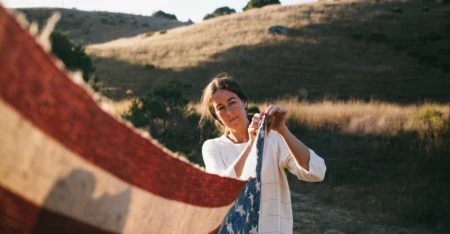Creating Climate-Beneficial Fiber Systems
How can we solve the climate crisis? The answer may exist beneath our feet, in the soil. Carbon is a finite resource that moves through soils, oceans, food, fibers and the atmosphere—and ancient carbon is fossilized in Earth’s core. There is no more carbon entering or leaving Earth—we are simply seeing the effects of having too much of it in the wrong place. But if we look to the carbon cycle itself, its movement pattern illuminates significant possibilities for transforming a crisis into a massive opportunity.
How? By restoring carbon to our global soils. Soil is the second largest source of carbon on the planet and we have lost 50–70 percent of the original carbon, much of which has oxidized upon exposure to air. Since the dawn of the Industrial Age we have brought 136 gigatons of carbon (one gigaton is equal to one billion tons) out of the soil.
Based upon data from a research effort by the Northeast Organic Farming Association, there are 8.3 billion acres of grasslands and 3.8 billion acres of cropland on the planet. Deploying soil carbon-building practices on those acres would restore 23.7 gigatons of carbon to our soils per year. By implementing regenerative farming practices, within five years we could create healthy soils, remove 106.25 gigatons of CO2 out of the atmosphere and return to atmospheric carbon dioxide levels considered safe by climate experts.This soil restoration work, coined carbon farming, manages landscapes in a way that enhances plants’ carbon uptake. Carbon farming can be done through time-tested practices such as applying compost to rangelands, no-till and pasture cropping, and repairing vegetation to creeks.
As the founder of Fibershed and the Board Chair of the Carbon Cycle Institute (CCI), I work with soil, atmospheric, and rangeland scientists, as well as farmers, ranchers and policy experts to move this strategy forward. We work with existing regional ranches and farms in the development of climate-beneficial fiber. Working with CCI, we have developed a carbon farm plan and on-ranch compost operation for one of the largest fine-fiber wool producers in California.
By putting our best understanding of soil science to work, we are paving the way for the production of fiber that carries a net-negative carbon impact. In the near future we envision garments that represent a wearable “carbon sink.” Made from natural fibers, grown on regenerated soils, clothing will come from and return to the soil. This is what we call the Soil-to-Soil Fiber System—designed to enhance the downward trajectory of carbon and to allow more people to wear clothing that exists in cooperation with Earth’s natural processes.
Our Choices Define Us
Choices are our beliefs set into action, and those actions set us down a path. Meet some Patagonia ambassadors and friends of the company who live their values through their actions. Then join us at one of many Patagonia store events this spring and summer. Rebecca will be teaching a Natural Dye Workshop at Patagonia San Francisco on May 4, 2016. Check the tour schedule to find an event near you.

